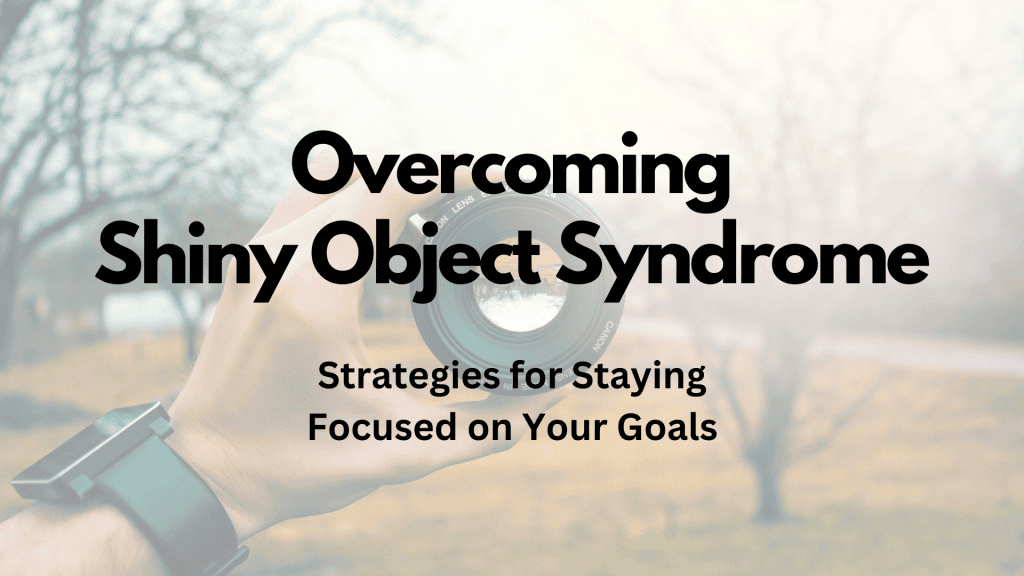
Shiny Object Syndrome is a common challenge where individuals are continually drawn to new ideas, projects, or goals, losing focus on their current tasks. This distraction can significantly hinder productivity and long-term success as it prevents one from completing endeavours already in progress.
The syndrome manifests itself in both personal and professional realms, affecting various aspects of life where sustained attention is crucial.

The path to overcoming this syndrome lies in the development of self-awareness and discipline.
By recognizing the pattern of continually chasing new, unproven ideas at the expense of current commitments, individuals can take the first step toward mitigating its effects.
Strategies such as setting clear goals, prioritizing tasks, and adhering to a structured plan are essential in combating the allure of constant newness.
Increased focus and deliberate decision-making are pivotal factors in overcoming Shiny Object Syndrome.
They enable individuals to weigh the true value of a new opportunity against the potential cost of diverting attention from existing projects.
With these tools, one can sustain the momentum required to see initiatives through to completion, thus paving the way for greater achievement and productivity.
Recognizing Shiny Object Syndrome

Before one can overcome Shiny Object Syndrome, it is essential to understand what it is, the triggers leading to it, and its impact on focus and progress.
Defining Shiny Object Syndrome
Shiny Object Syndrome is characterized by an individual's attraction to new ideas and projects at the expense of completing current initiatives. It is particularly prevalent among entrepreneurs who may prioritize novel ventures over ongoing ones. This syndrome results in a cycle where one continuously chases new ideas without seeing previous efforts to fruition.
Identifying Common Triggers
Key triggers of Shiny Object Syndrome include:
- Market Trends: An entrepreneur may notice a surge in a particular market trend and shift focus to capitalize on it.
- Innovative Technology: The allure of the latest technology can distract from current projects.
- Social Media: Success stories on social media can incite a desire to pursue a new idea seen online.
- Fear of Missing Out (FOMO): The worry that not pursuing a new opportunity could lead to missing out on significant benefits.
Recognizing these triggers can help individuals stay focused on their goals.
Understanding the Impact on Focus and Progress
The negative effects of Shiny Object Syndrome are manifested in several ways:
- Diverted Focus: Individuals may struggle to concentrate on any single task, splitting their attention among multiple promises of success.
- Stalled Progress: As they hop from one idea to the next, progress on any single initiative is often minimal, halting long-term success.
- Frequent Distraction: The constant search for something better can lead to a perpetual state of distraction, reducing overall productivity.
Understanding these impacts is crucial for maintaining direction and achieving set objectives.
Setting Clear Goals and Objectives

To overcome shiny object syndrome, it's crucial to establish clear goals and objectives, providing a focused path for consistent progress.
The Importance of Long-Term Goals
Long-term goals serve as a compass for success. They allow individuals to align their daily actions with their overarching vision. This alignment assures that effort and resources are invested wisely, fostering a sense of accomplishment.
With long-term goals in place, patience becomes a practised virtue, reducing the appeal of distractions that do not contribute to these goals.
| Aspect | Contribution to Success |
|---|---|
| Vision | Drives daily actions toward meaningful results. |
| Alignment | Keeps resources focused on predefined objectives. |
| Patience | Cultivates resilience against short-term temptations. |
Steps for Effective Goal Setting
Effective goal setting involves specific steps that facilitate the path from conception to achievement.
First, identify the end objective; this defines what success looks like.
Second, break down the goal into manageable tasks; this makes the process of achieving it less daunting.
Third, establish clear metrics for tracking progress; measurable milestones are important for maintaining momentum.
- Identify the End Objective
- Define what you are aiming to achieve.
- Break Down into Manageable Tasks
- Create a step-by-step plan to approach the goal.
- Establish Clear Metrics
- Determine success indicators for regular evaluation.
By setting clear goals and patient planning, individuals position themselves to resist the allure of short-lived trends and focus on actions that support long-term objectives.
Strategies to Overcome Distractions

Effective management of distractions requires strategic approaches aimed at prioritizing tasks, streamlining project management, and setting clear boundaries. These strategies help conserve energy and resources, improving productivity and the success rate of projects.
Prioritization Techniques
One begins to overcome distractions by accurately identifying which tasks are urgent and important, thereby managing their time effectively.
Prioritization can be achieved through the use of tools such as the Eisenhower Box:
- Urgent and Important: Tasks to do immediately.
- Important, Not Urgent: Tasks to schedule later.
- Urgent, Not Important: Tasks to delegate to someone else.
- Not Urgent, Not Important: Tasks to eliminate.
Utilizing such techniques sharpens focus and ensures that resources are allocated efficiently to high-priority tasks.
Project Management Essentials
Effective project management plays a crucial role in overcoming distractions. Key essentials include:
- Clear Objectives: Defining the project's outcomes.
- Milestones: Setting specific checkpoints.
- Resource Allocation: Assigning time and resources proactively.
Organized structures and methodical approaches enable one to remain focused on the project at hand while minimizing the impact of unrelated distractions.
Creating and Maintaining Boundaries
Establishing boundaries is vital for the sustenance of concentration:
- Work Hours: Fixed times dedicated strictly to work.
- Communication Guidelines: Rules for when and how team members can communicate.
- Personal Limits: Recognizing signs of fatigue and respecting personal limits to prevent burnout.
Boundaries help ensure productivity is not compromised by distractions. They allow individuals to maintain a clear division between work and other aspects of life, facilitating successful project completion over time.
Harnessing Commitment and Patience

In tackling shiny object syndrome, individuals must prioritize their commitment to goals and cultivate patience. These traits are fundamental in keeping focus and achieving long-term value through consistent efforts.
Cultivating Commitment in Pursuit of Objectives
Commitment anchors an individual's focus, enabling them to remain steadfast in the face of distractions. It begins with clearly defined objectives.
These objectives must be specific, measurable, achievable, relevant, and time-bound (SMART). Here is an approach to establishing and maintaining commitment:
- Defining Priorities:
- List top priorities that align with personal or professional goals.
- Identify actions necessary to achieve these priorities.
- Setting SMART Goals:
- Use a table to track objective progress: Objective Specific Measurable Achievable Relevant Time-Bound Example Define the exact outcome desired. Set criteria for measurement. Ensure the goal is attainable. Align with broader life goals. Set a deadline for achievement.
- Reviewing Goals Regularly:
- Establish a routine to review goals weekly or monthly.
- Adjust strategies as needed to stay on course.
Practicing Patience and Mindfulness
Patience is a virtue that fosters inner calm and the capacity to accept or tolerate delays without frustration. Mindfulness enhances this, providing the clarity to appreciate the journey and the satisfaction from each progressive step. Here's how to practice patience and mindfulness:
- Mindfulness Exercises:
- Engage in daily meditation focusing on breath or body sensations.
- Practice being present in every task, no matter how mundane.
- Reflection on Progress:
- Keep a journal documenting successes, challenges, and feelings.
- Regular reflection helps individuals recognize growth and builds patience.
- Delaying Instant Gratification:
- Introduce wait periods before acting on new desires.
- Assess the long-term value before pivoting to new projects or opportunities.
Evaluating Opportunities with a Critical Eye

When exploring new opportunities, it’s essential to assess their viability and how they align with one’s goals. This critical evaluation helps maintain focus and avoid impulsivity.
Assessing Feasibility and Alignment with Goals
One must first determine if the opportunity at hand is feasible. Factors to consider include:
- Resources Required: Are the necessary resources available?
- Time Investment: Does one have the time to commit?
- Skill Set: Do one's skills match the demands of the opportunity?
- Long-term Value: Will this opportunity contribute to long-term goals?
It is imperative to align the opportunity with one's strategic objectives. This assessment can be outlined in a simple table:
| Consideration | Evaluation Criteria |
|---|---|
| Goal Alignment | Does it support or detract from established goals? |
| Commitment Level | Is the commitment sustainable without overextending? |
| Potential Return | Is the expected benefit worth the investment? |
Avoiding Common Cognitive Biases in Decision-Making
When evaluating new opportunities, several cognitive biases can interfere with rational decision-making. These biases include:
- Sunk Cost Fallacy: Continuing a failing venture due to the investment already made. To combat this, one must be willing to abandon past investments when evidence suggests it's the best course of action.
- Trends and Fads: Decisions should not be solely based on what is currently popular or trending. Trends can lead to impulsive decisions without proper vetting. Reviewing historical and projected data can help separate fleeting trends from sustainable opportunities.
- Impulsivity: Immediate excitement can cloud judgment. Tool to manage impulsivity: Tool Method Decision Pause Implement a mandatory waiting period before committing. Consultation Seek diverse perspectives to challenge and expand one's view. Checklist Approach Use a pre-decided list of criteria to evaluate the opportunity objectively.
Frequently Asked Questions

This section addresses common concerns about managing ‘shiny object syndrome' and provides actionable solutions to stay focused.
What strategies can be employed to avoid distraction by new but unimportant opportunities?
Individuals can set clear goals, use time management techniques, and impose self-imposed deadlines to remain focused on their priorities rather than being lured by every new opportunity that appears appealing but may not be important.
How can psychological techniques be applied to combat the tendency toward ‘shiny object syndrome'?
Practising mindfulness and self-reflection helps individuals recognize the impulse to chase new opportunities. Developing awareness of patterns that lead to distractions can enable them to redirect their attention to their primary objectives.
What are effective methods for prioritizing tasks to mitigate the impact of ‘shiny object syndrome'?
One should evaluate tasks based on urgency and importance, and leverage prioritization frameworks like the Eisenhower Matrix. This approach assists in distinguishing between tasks that require immediate attention and those that can wait or be delegated.
How does one distinguish between genuine opportunities and distractions often associated with ‘shiny object syndrome'?
Scrutinizing new opportunities based on their alignment with long-term goals is crucial. Individuals should question the potential opportunity's relevance to their overarching objectives and whether it contributes to their strategic progress.
Can techniques from cognitive behavioural therapy be useful in dealing with ‘shiny object syndrome'?
Yes, cognitive behavioural therapy techniques can help individuals identify and alter thought patterns that contribute to their susceptibility to distraction. By challenging irrational beliefs and focusing on rational decision-making, one can better manage attraction to new ventures.
What steps can individuals take to improve focus and reduce susceptibility to ‘shiny object syndrome'?
Implementing structured routines, building healthy habits, and limiting exposure to environments that encourage constant novelty-seeking can significantly improve one's focus.
Additionally, using tools like distraction blockers can help maintain attention on the task at hand.
Share Your Journey, Learn More, and Thrive
I would love to hear about your experiences, challenges, and successes in the realm of affiliate marketing.
Share your thoughts, questions, or stories in the comments section below.
Let's build a community of aspiring and experienced affiliate marketers, supporting one another on this exciting journey.
For more valuable insights, tips, and guidance on affiliate marketing, subscribe to our newsletter.
Stay updated with the latest trends, tools, and strategies that can empower you in your pursuit of affiliate marketing success.

